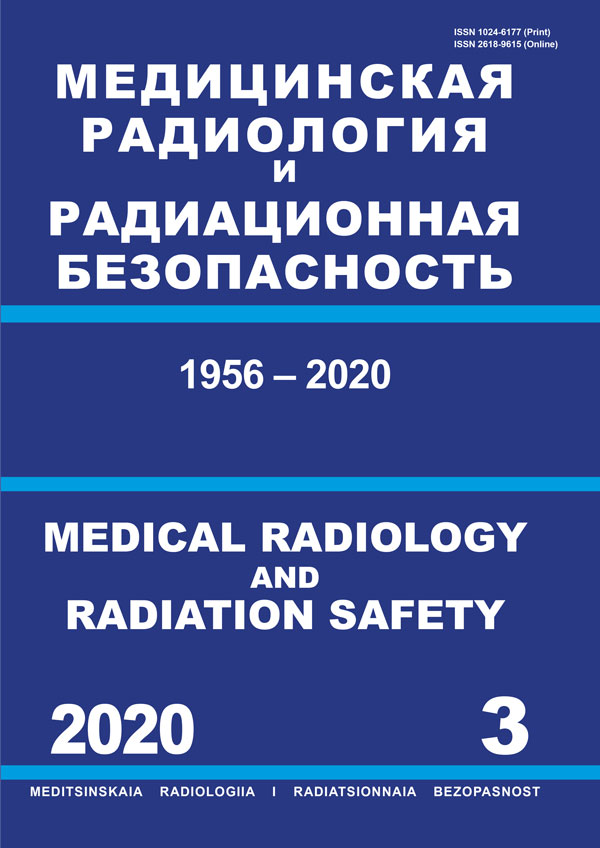Russian Federation
Russian Federation
Russian Federation
UDK 61 Медицина. Охрана здоровья
GRNTI 76.33 Гигиена и эпидемиология
OKSO 32.08.12 Эпидемиология
BBK 51 Социальная гигиена и организация здравоохранения. Гигиена. Эпидемиология
TBK 5708 Гигиена и санитария. Эпидемиология. Медицинская экология
BISAC MED028000 Epidemiology
BISAC MED080000 Radiology, Radiotherapy & Nuclear Medicine
Purpose: Analysis of the prevalence of diseases of non-professional genesis in individuals with intake of radionuclides through damaged skin and served by health care institutions of the Federal Medical and Biological Agency of Russia. Material and methods: The database of the “Industry register of persons with occupational diseases” includes the health indicators of individuals with intake of radionuclides through damaged skin and a population of 185 patients aged 68.9 ± 1.0 years for 2014 (166 men aged 68.3 ± 1.0 years and 19 women aged 74.0 ± 3.4 years). The coding of diseases of non-professional genesis was carried out according to the International Statistical Classification of Diseases and Problems Related to Health (ICD-10). Student’s criterion was used as a criterion of statistical validity (p < 0.05). To assess the health of persons counted in the register, the prevalence rate of diseases of non-professional genesis, calculated for 1000 patients with occupational diseases, was used. An intensive indicator error was calculated ( ± m 95 %). Results: The prevalence of non-occupational diseases is 1637.8 ± 94.1 (men 1614.5 ± 98.6, women 1842.1 ± 311.4; p > 0.05). Disorders of the musculoskeletal system occupy the first place – 340.5 ± 34.8; 20.8 % (men 313.3 ± 36.0; 19.4 %, women 578.9 ± 174.6; 31.4 %; p > 0.05). Of these, dorsopathies accounted for 286.5 ± 33.1; 84.1 % (men 265.1 ± 34.3; 84.6 %, women 473.7 ± 114.6; 81.8 %; p > 0.05). Diseases of the digestive organs are 270.3 ± 32.7; 16.5 %. The highest rates in persons with diseases of the esophagus, stomach and duodenum 205.4 ± 29.7; 76.0 % (men 210.8 ± 31.7; 76.1 %, women 157.9 ± 83.7; 75.0 %; p > 0.05). The third ranking place is divided by diseases of the eye and its adnexa 200.0 ± 29.4; 12.2 % (men 192.8 ± 30.6; 11.9 %, women, 263.2 ± 101.0; 14.3 %; p > 0.05) and circulatory system diseases 200.0 ± 29,4; 12.2 % (men 174.7 ± 29.5; 10.8 %, women 421.1 ± 113.3; 22.9 %; p > 0.05). In the structure of diseases of non-professional genesis, the diseases of the first four ranking places, including respiratory diseases, make up 73.6 % (men 72.4 %, women 82.9 %). Conclusion: Among the diseases in persons with the intake of radionuclides through damaged skin are the most common disorders of the musculoskeletal system, diseases of the digestive system, diseases of the eye and its appendage apparatus. In terms of frequency, they are inferior to diseases of the circulatory system and respiratory organs. As one of the solutions to the problem of registration in persons with signs of contamination of radionuclides of damaged skin in the framework of ICD-10, it is proposed to introduce code S61.2 as “Open wounds of wrist and hand with intake of radionuclides”.
skin damage, radionuclide intake, diseases of non-professional genesis
1. Bogdanov IM, Zaitsev EP, Ovchinnikov AV, et al. The organization of the control system and the issues of medical and sanitary support of personnel in the conditions of plutonium and americium radionuclide intake through damaged skin integuments. Medicine of Extreme Situations. 2018; 20(1):86-93. (In Russ.).
2. Belyaev IK, Zhorova ES, Kalistratova BC, et al. Radioactive substances and stab wounds. Medicine of Extreme Situations. 2011;13(1):41-52. (In Russ.).
3. MU 2.6.1.034-2014. “The order of interaction between the enterprises of Rosatom State Corporation and the bodies and organizations of the FMBA of Russia with non-standard (wound) and emergency inhalation intake of plutonium and americium-241 isotopes”. Methodical instructions. Moscow. 2014. 24 p. (In Russ.).
4. Maslyuk AI, Bogdanov IM, Simonenko PD. Features of the formation of internal doses of radiation personnel plutonium production of the Siberian Chemical Plant. Bulletin of Siberian Medicine. 2005;2(4):124-7. (In Russ.).
5. Okladnikova ND, Khokhryakov VV, Shevkunov VA, et al. Plutonium-239: Clinical and cytogenetic observation of the description of a case of high incorporation of a radionuclide (24 years of observation). Radiation Biology. Radioecology. 2004;44(4):415-9. (In Russ.).





